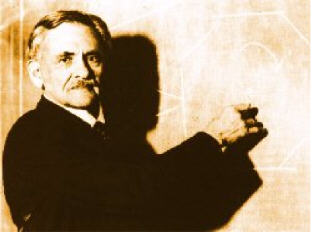THE BEGINNINGS OF THE INTERFEROMETER

Picture of Albert Michelson from http://hum.amu.edu.pl/~zbzw/ph/sci/aam.htm
Albert A. Michelson (1852-1931)
The Michelson interferometer was invented by American Physicist Albert A. Michelson in 1887. Michelson was born in Strzelno (Poland) in 1852 and moved to American in 1855. When he was 17, he joined the United States Naval Academy in Anapolis, Maryland where he excelled in science subjects. Michelson later became a science instructor at the academy, but moved on to become a professor of physics at several universities. During the years of 1923-1927, he was president of the National Academy of Sciences. In 1907, he was the first American to be awarded the Physics Nobel Prize for his many efforts in optics. Back to top.

Albert Michelson in 1887. Picture from http://hum.amu.edu.pl/~zbzw/ph/sci/aam.htm
Michelson began experimenting with the interferometer in April of 1887. He came up with a system of mirrors and semi-transparent mirrors (or beamsplitters) for merging separated beams of light, which are coming from the same source. The system was set up so that the beam of light was split in two, sending each split perpendicular to each other, and then merging back so they “interfered” with each other. Back to top.

Picture of interferometer setup from http://webphysics.davidson.edu/Alumni/DoNeumann/lab.htm/Interfer/contents.htm
Michelson and a colleague of his Dr. Edward Morley wanted to use the interferometer to determine whether or not ether existed by measuring it against the earth’s velocity. Ether was an all-pervasive fluid that was thought to make up the basic foundation of the universe. The theory was based on the principle that if the earth was traveling through light-conducting ether, then that speed of the light traveling in the same direction would be equal to the sum of the velocity of light and the velocity of the earth, and the speed of light traveling at right angles to the earth’s path would be expected to travel only at the velocity of light. This was determined by rotating the apparatus parallel to the Earth’s velocity “through the ether”, then the number of wavelengths in each path of light would change and the interference pattern would shift. In the beginning, the results were negative which meant that there was no difference in velocities. Back to top
In 1887, Michelson and Morley announced the experiment even though they only had negative results, but because the results were negative, they were proving that there was no Earth motion relative to ether. This changed the foundation of physics and led to Albert Einstein’s theory of relativity in 1905. Back to top.